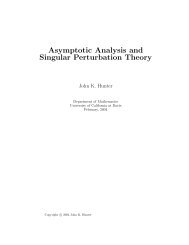The Riemann Integral
The Riemann Integral
The Riemann Integral
Create successful ePaper yourself
Turn your PDF publications into a flip-book with our unique Google optimized e-Paper software.
26 1. <strong>The</strong> <strong>Riemann</strong> <strong>Integral</strong><br />
1<br />
0.8<br />
0.6<br />
0.4<br />
0.2<br />
0<br />
−0.2<br />
−0.4<br />
−0.6<br />
−0.8<br />
−1<br />
0 0.05 0.1 0.15 0.2 0.25 0.3<br />
Figure 4. Graph of the <strong>Riemann</strong> integrable function y = sgn(sin(1/x)) in Example 1.44.<br />
where sgn is the sign function,<br />
⎧<br />
⎪⎨ 1 if x > 0,<br />
sgnx = 0 if x = 0,<br />
⎪⎩<br />
−1 if x < 0.<br />
<strong>The</strong>n f oscillates between 1 and −1 a countably infinite number of times as x →<br />
0 + (see Figure 4). It has jump discontinuities at x = 1/(nπ) and an essential<br />
discontinuityatx = 0. Nevertheless,itis<strong>Riemann</strong>integrable. Toseethis, notethat<br />
f is bounded on [0,1] and piecewise continuous with finitely many discontinuities<br />
on [r,1] for every 0 < r < 1. <strong>The</strong>orem 1.42 implies that f is <strong>Riemann</strong> integrable<br />
on [r,1], and then <strong>The</strong>orem 1.39 implies that f is integrable on [0,1].<br />
1.8. <strong>The</strong> fundamental theorem of calculus<br />
In the integral calculus I find much less interesting the parts that involve<br />
only substitutions, transformations, and the like, in short, the parts that<br />
involve the known skillfully applied mechanics of reducing integrals to<br />
algebraic, logarithmic, and circular functions, than I find the careful and<br />
profound study of transcendental functions that cannot be reduced to<br />
these functions. (Gauss, 1808)<br />
<strong>The</strong> fundamental theorem of calculus states that differentiation and integration<br />
are inverse operations in an appropriately understood sense. <strong>The</strong> theorem has two<br />
parts: in one direction, it says roughly that the integral of the derivative is the<br />
original function; in the other direction, it says that the derivative of the integral<br />
is the original function.
















